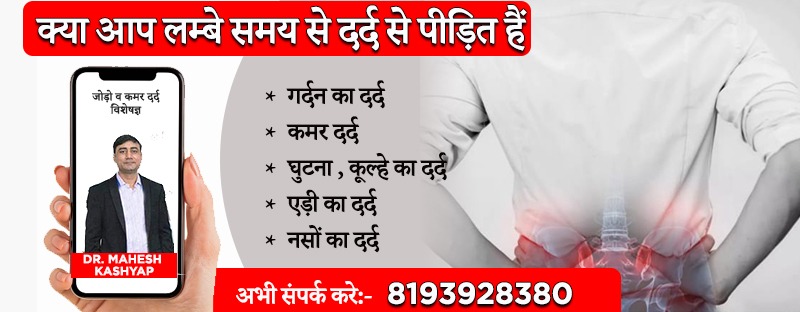
Pain Specialist

Dr. Mahesh Kashyap
Consultant Pain Physician (जोड़ो और कमर दर्द रोग विशेषज्ञ)India’s Most Advanced Non-Surgical Pain Treatment Services

Trusted by over 1000 patients, Our Pain Management Centre is the pioneer in providing non-surgical pain treatment services in India. Treatment for all major chronic pain conditions like back pain, slipped disc, sciatic pain, knee pain, joint pains, arthritis, neuralgic pain, headaches and migraines is provided using the latest and most advanced treatment modalities like ozone discectomy, radiofrequency lesioning, Platelet Rich Plasma (PRP) therapy, spinal cord stimulator implant, and vertebroplasty.
Pain management is a complex and ever-changing specialty where new modalities are developed and tested out continuous. We make sure to use the latest and most advanced clinically-proven pain management techniques to treat your pain without surgery.
Why doesn’t my pain go away?
Health professionals use different terms for different types of pain. Shortterm pain, such as a sprained ankle, is called ‘acute’ pain. Long-term pain, such as back pain, is called ‘persistent’ or ‘chronic’ pain. Pain that comes and goes, like a headache, is called ‘recurrent’ pain. It is not unusual to have more than one sort of pain, or to have pain in several places. Many acute pains are a useful alarm signal that something is wrong. Most minor ones get better on their own or with simple treatment. Others may be a sign of something more serious, such as a broken leg. This pain is helpful because it means that you get treatment and rest your leg until the break has had a chance to heal. On the other hand, persistent pain appears to serve no useful purpose, but has a huge effect on the lives of many people.
The Pain Mechanism
Pain can come from any part of your body : skin, muscle, ligaments, joints, bones (nociceptive pain), injured tissue (inflammatory pain), nerves (neuropathic pain), internal organs (visceral pain) or a combination of these types of pain (mixed pain). Pain signals normally travel from the painful part of the body along thousands of specialised nerve fibres, through the spinal cord, to the brain. However, in some cases (for example, pain after a stroke), damage to the brain or to the spinal cord itself can start the pain sensation. Pain signals are initially processed in the spinal cord and then in the brain, where there are connections with centres associated with anxiety, emotions, sleep, appetite and memory. This creates a very personal experience of pain for each person. The brain sends signals back to the spinal cord, which can, in turn, either reduce or increase the pain further.